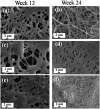Sustained delivery of calcium and orthophosphate ions from amorphous calcium phosphate and poly(L-lactic acid)-based electrospinning nanofibrous scaffold
- PMID: 28361908
- PMCID: PMC5374505
- DOI: 10.1038/srep45655
Sustained delivery of calcium and orthophosphate ions from amorphous calcium phosphate and poly(L-lactic acid)-based electrospinning nanofibrous scaffold
Abstract
The purpose of this study is to investigate electrospinning poly(L-lactic acid) (PLLA) nanofibrous scaffold with different contents of amorphous calcium phosphate (ACP), which is suitable for using in bone regeneration through sustained release of calcium and orthophosphate ions. Three groups of nanofibrous scaffolds, ACP-free PLLA, ACP-5 wt%/PLLA and ACP-10 wt%/PLLA, are developed and characterized by scanning electron microscopy and gel permeation chromatography. Calcium and phosphate colorimetric assay kits are used to test ions released from scaffold during hydrolytic degradation. The results show ACP-5 wt%/PLLA and ACP-10 wt%/PLLA scaffolds have relatively high degradation rates than ACP-free PLLA group. The bioactivity evaluation further reveals that ACP-5 wt%/PLLA scaffold presents more biocompatible feature with pre-osteoblast cells and significant osteogenesis ability of calvarial bone defect. Due to the facile preparation method, sustained calcium and orthophosphate release behavior, and excellent osteogenesis capacity, the presented ACP/PLLA nanofibrous scaffold has potential applications in bone tissue engineering.
Conflict of interest statement
The authors declare no competing financial interests.
Figures







Similar articles
-
Effect of novel bioresorbable scaffold composed of poly-L-lactic acid and amorphous calcium phosphate nanoparticles on inflammation and calcification of surrounding tissues after implantation.J Mater Sci Mater Med. 2018 Jul 17;29(8):112. doi: 10.1007/s10856-018-6125-6. J Mater Sci Mater Med. 2018. PMID: 30019182
-
Fabrication and characterization of poly (ethylenimine) modified poly (l-lactic acid) nanofibrous scaffolds.J Biomater Sci Polym Ed. 2019 Nov;30(16):1523-1541. doi: 10.1080/09205063.2019.1648015. Epub 2019 Aug 8. J Biomater Sci Polym Ed. 2019. PMID: 31359828
-
Composite poly(l-lactic-acid)/silk fibroin scaffold prepared by electrospinning promotes chondrogenesis for cartilage tissue engineering.J Biomater Appl. 2016 May;30(10):1552-65. doi: 10.1177/0885328216638587. Epub 2016 Apr 7. J Biomater Appl. 2016. PMID: 27059497
-
A review of recent advances of piezoelectric poly-L-lactic acid for biomedical applications.Int J Biol Macromol. 2024 Sep;276(Pt 1):133748. doi: 10.1016/j.ijbiomac.2024.133748. Epub 2024 Jul 8. Int J Biol Macromol. 2024. PMID: 38986996 Review.
-
Electro-spun piezoelectric PLLA smart composites as a scaffold on bone fracture: A review.Regen Ther. 2025 Feb 20;28:591-605. doi: 10.1016/j.reth.2025.01.026. eCollection 2025 Mar. Regen Ther. 2025. PMID: 40061293 Free PMC article. Review.
Cited by
-
Developing Porous Ortho- and Pyrophosphate-Containing Glass Microspheres; Structural and Cytocompatibility Characterisation.Bioengineering (Basel). 2022 Oct 25;9(11):611. doi: 10.3390/bioengineering9110611. Bioengineering (Basel). 2022. PMID: 36354522 Free PMC article.
-
Cytocompatibility and Bioactive Ion Release Profiles of Phosphoserine Bone Adhesive: Bridge from In Vitro to In Vivo.Biomedicines. 2022 Mar 22;10(4):736. doi: 10.3390/biomedicines10040736. Biomedicines. 2022. PMID: 35453486 Free PMC article.
-
Composite Drug Delivery System Based on Amorphous Calcium Phosphate-Chitosan: An Efficient Antimicrobial Platform for Extended Release of Tetracycline.Pharmaceutics. 2021 Oct 11;13(10):1659. doi: 10.3390/pharmaceutics13101659. Pharmaceutics. 2021. PMID: 34683952 Free PMC article.
-
Electrospun Scaffolds of Polylactic Acid, Collagen, and Amorphous Calcium Phosphate for Bone Repair.Pharmaceutics. 2023 Oct 25;15(11):2529. doi: 10.3390/pharmaceutics15112529. Pharmaceutics. 2023. PMID: 38004509 Free PMC article.
-
Amorphous Calcium Phosphate and Amorphous Calcium Phosphate Carboxylate: Synthesis and Characterization.ACS Omega. 2023 Jul 17;8(30):26782-26792. doi: 10.1021/acsomega.3c00796. eCollection 2023 Aug 1. ACS Omega. 2023. PMID: 37546623 Free PMC article.
References
-
- Cui F. Z., Li Y. & Ge J. Self-assembly of mineralized collagen composites. Mat. Sci. Eng. R 57, 1–27 (2007).
-
- Niu X. F., Feng Q. L., Wang M. B., Guo X. D. & Zheng Q. X. Porous nano-HA/collagen/PLLA scaffold containing chitosan microspheres for controlled delivery of synthetic peptide derived from BMP-2. J. Control. Release 134, 111–117 (2009). - PubMed
-
- Olszta M. J. et al.. Bone structure and formation: A new perspective. Mat. Sci. Eng. R 58, 77–116 (2007).
-
- Wegst U. G. K., Bai H., Saiz E., Tomsia A. P. & Ritchie R. O. Bioinspired structural materials. Nat. Mater. 14, 23–36 (2015). - PubMed
-
- Huang Y. et al.. Effects of hydroxyapatite/collagen composite on osteogenic differentiation of rat bone marrow derived mesenchymal stem cells. J. Compos. Mater. 48, 1971–1980 (2014).
Publication types
MeSH terms
Substances
LinkOut - more resources
Full Text Sources
Other Literature Sources

